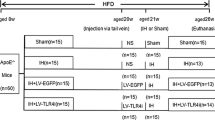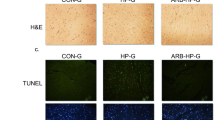Abstract
Purpose
It has been established that obstructive sleep apnea (OSA) is an independent risk factor for atherosclerosis. Chronic intermittent hypoxia (CIH) activates sympathoadrenal system and upregulates β3 adrenergic receptor (β3 AR). However, the effect of selective β3 AR agonist mirabegron in CIH-induced atherosclerosis remains unknown.
Methods
We generated a CIH-induced atherosclerosis model through exposing ApoE−/− mice to CIH (8 h per day, cyclic inspiratory oxygen fraction 5–21%, 60-s cycle) for 6 weeks after 4-week high-fat dieting and investigated the effects of mirabegron, a selective β3 AR agonist, on CIH-induced atherosclerosis. The coronary endarterectomy (CE) specimens from coronary artery disease patients with OSA and without OSA were collected.
Results
The expression of β3 AR was significantly elevated in CIH-induced atherosclerosis model. Furthermore, treatment with mirabegron (10mg/kg per day by oral administration for 6 weeks) ameliorated atherosclerosis in ApoE−/− mice in CIH but not in normoxia. Mechanistically, mirabegron activated β3 AR and ameliorated intraplaque oxidative stress by suppressing p22phox expression and reactive oxygen species (ROS) level. In addition, in human CE specimens, β3 AR was also upregulated associated with increased p22phox expression and ROS level both in the lumen and in the plaque of coronary artery in OSA subjects.
Conclusion
This study first demonstrated that mirabegron impeded the progression of CIH-induced atherosclerosis, at least in part, via β3 AR–mediated oxidative stress, suggesting a promising therapeutic strategy for protecting against atherosclerosis induced by CIH.





Similar content being viewed by others
Availability of Data and Material
The datasets used or analyzed during the current study are available from the corresponding author on reasonable request.
References
Chen X, He Y, Fu W, Sahebkar A, Tan Y, Xu S, et al. Histone deacetylases (HDACs) and atherosclerosis: a mechanistic and pharmacological review. Front Cell Dev Biol. 2020;8:581015.
Jain T, Nikolopoulou EA, Xu Q, Qu A. Hypoxia inducible factor as a therapeutic target for atherosclerosis. Pharmacol Ther. 2018;183:22–33.
Remme WJ. The sympathetic nervous system and ischaemic heart disease. Eur Heart J. 1998;19:F62–71.
Berbée JF, Boon MR, Khedoe PP, et al. Brown fat activation reduces hypercholesterolaemia and protects from atherosclerosis development. Nat Commun. 2015;6:6356.
Gambardella J, Wang X, Mone P, Khondkar W, Santulli G. Genetics of adrenergic signaling drives coronary artery calcification. Atherosclerosis. 2020;310:88–90.
Drager LF, McEvoy RD, Barbe F, Lorenzi-Filho G, Redline S, INCOSACT Initiative (International Collaboration of Sleep Apnea Cardiovascular Trialists). Sleep apnea and cardiovascular disease: lessons from recent trials and need for team science. Circulation. 2017;136:1840–50.
Ma L, Zhang J, Liu Y. Roles and mechanisms of obstructive sleep apnea-hypopnea syndrome and chronic intermittent hypoxia in atherosclerosis: evidence and prospective. Oxidative Med Cell Longev. 2016;8215082.
Bae S, Xiao Y, Li G, Casiano CA, Zhang L. Effect of maternal chronic hypoxic exposure during gestation on apoptosis in fetal rat heart. Am J Physiol Heart Circ Physiol. 2003;285(3):H983–90.
Xu X, Lu WJ, Shi JY, Su YL, Liu YC, Wang L, et al. The gut microbial metabolite phenylacetylglycine protects against cardiac injury caused by ischemia/reperfusion through activating β2AR. Arch Biochem Biophys. 2021;697:108720.
Arioglu-Inan E, Kayki-Mutlu G, Michel MC. Cardiac β (3) -adrenoceptors-a role in human pathophysiology? Br J Pharmacol. 2019;176:2482–95.
Nagai H, Kuwahira I, Schwenke DO, Tsuchimochi H, Nara A, Ogura S, et al. Pulmonary macrophages attenuate hypoxic pulmonary vasoconstriction via β3AR/iNOS pathway in rats exposed to chronic intermittent hypoxia. PLoS One. 2015;10:e0131923.
Vij M, Drake MJ. Clinical use of the beta3 adrenoceptor agonist mirabegron in patients with overactive bladder syndrome. Ther Adv Urol. 2015;7:241–8.
Bundgaard H, Axelsson A, Hartvig Thomsen J, Sørgaard M, Kofoed KF, Hasselbalch R, et al. The-first-in-man randomized trial of a beta3 adrenoceptor agonist in chronic heart failure: the BEAT-HF trial. Eur J Heart Fail. 2017;19:566–75.
Pouleur AC, Anker S, Brito D, Brosteanu O, Hasenclever D, Casadei B, et al. Rationale and design of a multicentre, randomized, placebo-controlled trial of mirabegron, a beta3-adrenergic receptor agonist on left ventricular mass and diastolic function in patients with structural heart disease beta3-left ventricular hypertrophy (Beta3-LVH). ESC Heart Fail. 2018;5(5):830–41.
García-Álvarez A, Pereda D, García-Lunar I, Sanz-Rosa D, Fernández-Jiménez R, García-Prieto J, et al. Beta-3 adrenergic agonists reduce pulmonary vascular resistance and improve right ventricular performance in a porcine model of chronic pulmonary hypertension. Basic Res Cardiol. 2016;111(4):49.
Hadi T, Douhard R, Dias AMM, et al. Beta3 adrenergic receptor stimulation in human macrophages inhibits NADPH oxidase activity and induces catalase expression via PPARγ activation. Biochim Biophys Acta. 1864;2017:1769–84.
Mo W, Michel MC, Lee XW, Kaumann AJ, Molenaar P. The beta (3) -adrenoceptor agonist mirabegron increases human atrial force through beta (1) -adrenoceptors: an indirect mechanism? Br J Pharmacol. 2017;174(16):2706–15.
Korstanje C, Suzuki M, Yuno K, Sato S, Ukai M, Schneidkraut MJ, et al. Translational science approach for assessment of cardiovascular effects and proarrhythmogenic potential of the beta-3 adrenergic agonist mirabegron. J Pharmacol Toxicol Methods. 2017;87:74–81.
Poulain L, Thomas A, Rieusset J, Casteilla L, Levy P, Arnaud C, et al. Visceral white fat remodelling contributes to intermittent hypoxia-induced atherogenesis. Eur Respir J. 2014;43(2):513–22.
Sui W, Li H, Yang Y, Jing X, Xue F, Cheng J, et al. Bladder drug mirabegron exacerbates atherosclerosis through activation of brown fat-mediated lipolysis. Proc Natl Acad Sci U S A. 2019;116:10937–42.
Berry RB, Budhiraja R, Gottlieb DJ, Gozal D, Iber C, Kapur VK, et al. Rules for scoring respiratory events in sleep: update of the 2007 AASM Manual for the Scoring of Sleep and Associated Events. Deliberations of the Sleep Apnea Definitions Task Force of the American Academy of Sleep Medicine. J Clin Sleep Med. 2012;8:597–619.
Binsalamah ZM, Al-Sarraf N, Chaturvedi RK, et al. Mid-term outcome and angiographic follow-up of endarterectomy of the left anterior descending artery in patients undergoing coronary artery bypass surgery. J Card Surg. 2014;29:1–7.
Wu QQ, Xiao Y, Duan MX, Yuan Y, Jiang XH, Yang Z, et al. Aucubin protects against pressure overload-induced cardiac remodelling via the β3 -adrenoceptor-neuronal NOS cascades. Br J Pharmacol. 2018;175(9):1548–66.
Bruno G, Cencetti F, Pini A, Tondo A, Cuzzubbo D, Fontani F, et al. β3-adrenoreceptor blockade reduces tumor growth and increases neuronal differentiation in neuroblastoma via SK2/S1P2 modulation. Oncogene. 2020;39(2):368–84.
Love MI, Huber W, Anders S. Moderated estimation of fold change and dispersion for RNA-seq data with DESeq2. Genome Biol. 2014;15:550.
Murayama H, Eguchi A, Nakamura M, Kawashima M, Nagahara R, Mizukami S, et al. Spironolactone in combination with α-glycosyl isoquercitrin prevents steatosis-related early hepatocarcinogenesis in rats through the observed NADPH oxidase modulation. Toxicol Pathol. 2018;46(5):530–9.
Laouafa S, Ribon-Demars A, Marcouiller F, Roussel D, Bairam A, Pialoux V, et al. Estradiol protects against cardiorespiratory dysfunctions and oxidative stress in intermittent hypoxia. Sleep. 2017;40(8):1–13.
Savransky V, Nanayakkara A, Li J, Bevans S, Smith PL, Rodriguez A, et al. Chronic intermittent hypoxia induces atherosclerosis. Am J Respir Crit Care Med. 2007;175:1290–7.
Song D, Fang G, Mao SZ, Ye X, Liu G, Miller EJ, et al. Selective inhibition of endothelial NF-κB signaling attenuates chronic intermittent hypoxia-induced atherosclerosis in mice. Atherosclerosis. 2018;270:68–75.
Phillips CL, Yee BJ, Marshall NS, Liu PY, Sullivan DR, Grunstein RR. Continuous positive airway pressure reduces postprandial lipidemia in obstructive sleep apnea: a randomized, placebo-controlled crossover trial. Am J Respir Crit Care Med. 2011;184:355–61.
Kato M, Roberts-Thomson P, Phillips BG, Haynes WG, Winnicki M, Accurso V, et al. Impairment of endothelium- dependent vasodilation of resistance vessels in patients with obstructive sleep apnea. Circulation. 2000;102:2607–10.
Drager LF, Bortolotto LA, Maki-Nunes C, Trombetta IC, Alves MJNN, Fraga RF, et al. The incremental role of obstructive sleep apnoea on markers of atherosclerosis in patients with metabolic syndrome. Atherosclerosis. 2010;208:490–5.
Drager LF, Togeiro SM, Polotsky VY, Lorenzi-Filho G. Obstructive sleep apnea: a cardiometabolic risk in obesity and the metabolic syndrome. J Am Coll Cardiol. 2013;62(7):569–76.
Young T, Finn L, Peppard PE, et al. Sleep disordered breathing and mortality: eighteen-year follow-up of the Wisconsin sleep cohort. Sleep. 2008;31:1071–8.
Marin JM, Carrizo SJ, Vicente E, Agusti AG. Long-term cardiovascular outcomes in men with obstructive sleep apnoea-hypopnoea with or without treatment with continuous positive airway pressure: an observational study. Lancet. 2005;365:1046–53.
Light M, McCowen K, Malhotra A, Mesarwi OA. Sleep apnea, metabolic disease, and the cutting edge of therapy. Metabolism. 2018;84:94–8.
Dehvari N, da Silva Junior ED, Bengtsson T, Hutchinson DS. Mirabegron: potential off target effects and uses beyond the bladder. Br J Pharmacol. 2018;175(21):4072–82.
van Gelderen M, Stölzel M, Meijer J, Kerbusch V, Collins C, Korstanje C. An exploratory study in healthy male subjects of the mechanism of mirabegron-induced cardiovascular effects. J Clin Pharmacol. 2017;57(12):1534–44.
Hatanaka T, Ukai M, Watanabe M, Someya A, Ohtake A, Suzuki M, et al. In vitro and in vivo pharmacological profile of the selective β3-adrenoceptor agonist mirabegron in rats. Naunyn Schmiedeberg's Arch Pharmacol. 2013;386(3):247–53.
Black SM. β3-Adrenoceptor, glutathionylation, and diabetic cardiomyopathy. Focus on “beta3 adrenoceptor activation relieves oxidative inhibition of the cardiac Na+-K+ pump in hyperglycemia induced by insulin receptor blockade”. Am J Phys Cell Phys. 2015;309:C283–5.
Leo S, Gattuso A, Mazza R, et al. Cardiac influence of the β3-adrenoceptor in the goldfish (Carassius auratus): a protective role under hypoxia? J Exp Biol. 2019;222(Pt 19):jeb211334. Published 2019 Oct 10.
Sikarwar AS, Hinton M, Santhosh KT, Dhanaraj P, Talabis M, Chelikani P, et al. Hypoxia inhibits adenylyl cyclase catalytic activity in a porcine model of persistent pulmonary hypertension of the newborn. Am J Phys Lung Cell Mol Phys. 2018;315(6):L933–44.
Wiktorowska-Owczarek A, Owczarek J. The effect of hypoxia on PGE2-stimulated cAMP generation in HMEC-1. Cell Mol Biol Lett. 2015;20(2):213–21.
Lee LC, Maurice DH, Baillie GS. Targeting protein-protein interactions within the cyclic AMP signaling system as a therapeutic strategy for cardiovascular disease. Future Med Chem. 2013;5(4):451–64.
Milano S, Gerbino A, Schena G, Carmosino M, Svelto M, Procino G. Human β3-adrenoreceptor is resistant to agonist-induced desensitization in renal epithelial cells. Cell Physiol Biochem. 2018;48(2):847–62.
Ursino MG, Vasina V, Raschi E, et al. The beta3-adrenoceptor as a therapeutic target: current perspectives. Pharmacol Res. 59(4):221–34.
Funding
This work was supported by the Beijing Natural Science Foundation and Municipal Education Commission Grant KZ202010025045; Beijing Talents Project 2020A39; the National Natural Science Foundation of China (NSFC) Grants 81670317, 82071573, and 81470492, and Capitals’ s Funds for Health Improvement and Research of China 2018-2-2064 to Xiao-fan Wu.
Author information
Authors and Affiliations
Contributions
Yue Wang (the first author) and Yue Wang (the second author) performed experiments, analyzed and interpreted the data, and drafted the manuscript; Hong-feng Jiang, Meng-ru Liu, Xin-yan Liu and Jiang Xie conducted the experiments; Hai-ming Dang and Yang Yu performed coronary endarterectomy. Xiao-jun Zhan and Hui-na Zhang provided reagents, analyzed and interpreted the data and edited the paper. Xiao-fan Wu contributed resources and secured funding, designed research, supervised the project and reviewed the manuscript. Yue Wang (the first author) is a doctorial candidate of grade 2020; Yue Wang (the second author) is a doctorial candidate of grade 2019. The two authors contributed equally to this work.
Corresponding author
Ethics declarations
Ethics Approval
All procedures involving human participants were authorized by the Medical Ethics Committee of Beijing Anzhen Hospital and adhered to the Declaration of Helsinki and its later amendments or comparable ethical standards. All procedures involving animals were approved by the Capital Medical University Animal Experimentation Ethics Committee and carried out in accordance with the National Institutes of Health Guide for the Care and Use of Laboratory Animals.
Consent to Participate
Written informed consent was obtained from all subjects enrolled in this study.
Conflict of Interest
The authors declare no competing interests.
Additional information
Publisher’s Note
Springer Nature remains neutral with regard to jurisdictional claims in published maps and institutional affiliations.
Supplementary Information
ESM 1
(DOCX 2273 kb)
Rights and permissions
About this article
Cite this article
Wang, Y., Wang, Y., Jiang, Hf. et al. Mirabegron Ameliorated Atherosclerosis of ApoE−/− Mice in Chronic Intermittent Hypoxia but Not in Normoxia. Cardiovasc Drugs Ther 36, 805–815 (2022). https://doi.org/10.1007/s10557-021-07196-w
Accepted:
Published:
Issue Date:
DOI: https://doi.org/10.1007/s10557-021-07196-w




